Iraqis call it Assur, the Fence. In English everyone calls it the Wall, and in the past two years it has grown and grown until it has become an almost continuous rampart, at least 16km in circumference, around the seat of US power in Baghdad.
The wall is not a small factor in the lives of ordinary Iraqis outside it. Khalid Daoud, an employee at the Culture Ministry, still looks in disbelief at the barrier of 3.6m high five-tonne slabs that cuts through his garden.
This is one snapshot of life for countless Iraqis who live, work, shop and kick soccer balls around in the shadow of the structure. Many despise the wall, a few are strangely drawn to it, but no one can ignore it. Fortifications of one kind or another abound in the city, but there is nothing that compares to the snaking, zigzagging loop that is the wall.
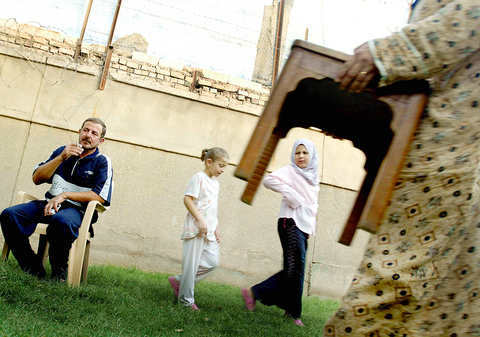
PHOTO: NY TIMES NEWS SERVICE
Sometimes likened to the Berlin Wall by those who are not happy about its presence, the structure cleanly divides the relative safety of the Green Zone, which includes Saddam Hussein's old palace and ministry complex, now used by the US authorities and heavily patrolled by US troops, from the Red Zone -- most of the rest of Baghdad -- where security ranges from adequate to nonexistent.
But for all the problems faced by residents across the city, the neighborhoods within a few blocks of the wall have become a world apart. Mortar rounds and rockets fired at the Green Zone fall short and land there. Suicide bombers, unable to breach the wall, explode in shops just outside it. And the maze of checkpoints, blocked streets and rumbling US armor may be thicker here than anywhere else in Baghdad.
"We are the new Palestine," said Saman Abdel Aziz Rahman, owner of the Serawan kebab restaurant, hard upon the northern reaches of the wall.
Two weeks ago a man walked into a restaurant a few doors from the Serawan and blew himself up at lunchtime, killing 23 people, wounding 36 and sending pieces of flesh all the way to Rahman's establishment.
One of the paradoxes of the wall is that while many are repelled by it, others are drawn by the feeling that they will be protected by the overwhelming might that lies just on the other side. US foot patrols, rarely seen elsewhere in Baghdad, are fairly routine along the outside of the wall, and residents know that any sustained guerrilla incursion near the zone would draw a swarm of Apache helicopters and Humvees, as well as a tank or two if necessary.
The stretch of wall near the Serawan, which is faced with a stucco-like material, is not new. It is there that the wall encloses the Assassin's Gate, the bulky arch above a boulevard leading to Saddam's former Republican Palace. Even though the Americans doubled its height with a chain-link fence, barbed wire and a green tarpaulin on top, there is little sense that the structure has blighted the neighborhood.
Soad Harb, an engineer who lives with her family next to the July 14th Bridge in a well-appointed apartment that senior officials in Saddam's government abandoned in 2003, said she was happy to live so close to the southern boundary of the Green Zone, where she sometimes finds work with Fluor, a big US contractor.
Harb said that while the US checkpoint at the end of the bridge made the neighborhood dangerous and noisy, the soldiers who walked through the area talking with children made the barrier seem less intimidating.
But the same cannot be said in the middle-class district of Harithiya, just beyond the western edge of the Green Zone, where the great concrete slabs arrived about two months ago.
Sometimes called blast walls because the steel reinforcing inside is designed to withstand explosions, the slabs are a looming, sinister presence facing a long line of family homes from across Al-Shawaf Street in Harithiya.
Haider al-Shawaf, a 35-year-old businessman who grew up here, first described the unpleasantness of the wall with a crude US expression. Then, as helicopters clattered to and fro overhead, Shawaf said nervously, "I am afraid of the Americans here -- afraid of this wall."
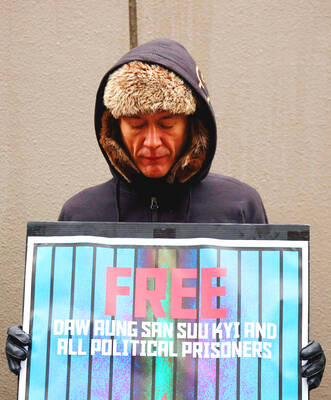
The Burmese junta has said that detained former leader Aung San Suu Kyi is “in good health,” a day after her son said he has received little information about the 80-year-old’s condition and fears she could die without him knowing. In an interview in Tokyo earlier this week, Kim Aris said he had not heard from his mother in years and believes she is being held incommunicado in the capital, Naypyidaw. Aung San Suu Kyi, a Nobel Peace Prize laureate, was detained after a 2021 military coup that ousted her elected civilian government and sparked a civil war. She is serving a
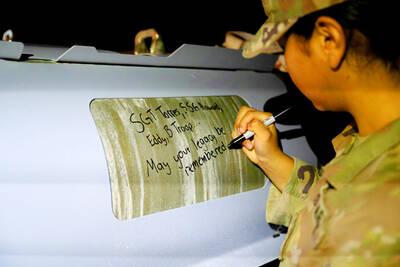
REVENGE: Trump said he had the support of the Syrian government for the strikes, which took place in response to an Islamic State attack on US soldiers last week The US launched large-scale airstrikes on more than 70 targets across Syria, the Pentagon said on Friday, fulfilling US President Donald Trump’s vow to strike back after the killing of two US soldiers. “This is not the beginning of a war — it is a declaration of vengeance,” US Secretary of Defense Pete Hegseth wrote on social media. “Today, we hunted and we killed our enemies. Lots of them. And we will continue.” The US Central Command said that fighter jets, attack helicopters and artillery targeted ISIS infrastructure and weapon sites. “All terrorists who are evil enough to attack Americans are hereby warned
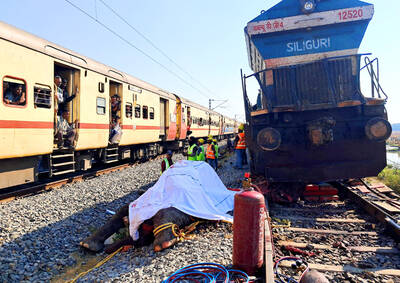
Seven wild Asiatic elephants were killed and a calf was injured when a high-speed passenger train collided with a herd crossing the tracks in India’s northeastern state of Assam early yesterday, local authorities said. The train driver spotted the herd of about 100 elephants and used the emergency brakes, but the train still hit some of the animals, Indian Railways spokesman Kapinjal Kishore Sharma told reporters. Five train coaches and the engine derailed following the impact, but there were no human casualties, Sharma said. Veterinarians carried out autopsies on the dead elephants, which were to be buried later in the day. The accident site
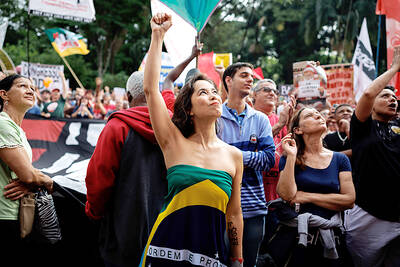
‘NO AMNESTY’: Tens of thousands of people joined the rally against a bill that would slash the former president’s prison term; President Lula has said he would veto the bill Tens of thousands of Brazilians on Sunday demonstrated against a bill that advanced in Congress this week that would reduce the time former president Jair Bolsonaro spends behind bars following his sentence of more than 27 years for attempting a coup. Protests took place in the capital, Brasilia, and in other major cities across the nation, including Sao Paulo, Florianopolis, Salvador and Recife. On Copacabana’s boardwalk in Rio de Janeiro, crowds composed of left-wing voters chanted “No amnesty” and “Out with Hugo Motta,” a reference to the speaker of the lower house, which approved the bill on Wednesday last week. It is